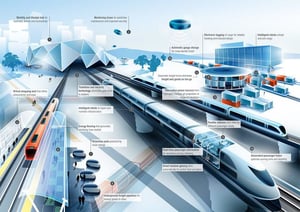 Technology is affecting transportation modes through the roads, sky and water. Advancements in speed and efficiency may come at some cost.
Technology is affecting transportation modes through the roads, sky and water. Advancements in speed and efficiency may come at some cost.
Along with tech innovations come ethical questions and concerns over autonomous systems replacing human workers. After all, what will happen to cargo workers when autonomous cargo ships eliminate the need for crew members to be on board during transit? Driverless cars and trucks will impact truck drivers, with one study estimating that as many as 294,000 driving positions could be eliminated over the next 25 years.
Despite these concerns, the future of transportation technology is inevitable. Let’s take a look at some changes coming to the future of freight and cargo transportation, and the effects on workers, safety, and costs.
Maglev and Hyperloop Trains
High-speed trains that operate using magnetic levitation from powerful electromagnets are already operating in Asia, and the first maglev train in the U.S. could be operating for public use as early as this year. In addition to being safer and timelier than traditional trains, they also encounter less delays due to weather and mechanics. Another similar concept from visionary Elon Musk is the Hyperloop. This transportation tube could run freight through a depressurized tube at speeds of 600 mph or more. Some freight industry experts believe it could be faster and cheaper than air transport, which is why DP World Cargospeed is investing big in the technology and hopes to have it in operation in 2021.
While the future of maglev for public use is almost a certainty, it’s impact on freight is less clear. Logistically and economically, it’s a nightmare for cities to completely rebuild their railway system, so many have opted instead to update their current lines rather than adapt for maglev. Maglev is not cheap, with a line project operating from Tokyo to Osaka expected to cost a whopping 49 billion or more.
Delivery Drones
The Federal Aviation Administration (FAA) recently issued guidelines and certifications for Unmanned Aircraft Systems (UAS) that include commercial operators of drones up to 55 lbs. They also recently approved UPS drone delivery for prescription medications, which signals that the FAA is finally warming up to the idea of full-scale commercial drone deliveries.
Drone technology is already proven to work effectively, but it does pose privacy and safety risks. Long-term reliability will need to be proven before the FAA makes these flying robots “type certified” for widespread use. If and when they do become “type certified”, the technology should reduce road congestion and traffic fatalities by taking delivery drivers off the road.
Driverless Cars and Trucks
Autonomous vehicles also promise to make our roads safer using artificial intelligence, telematics, and robotic technology. This technology is advancing rapidly and is just a few regulatory steps away from becoming mainstream. Tesla, Audi, Uber, and Volkswagen’s driverless technologies are already making headlines, both good and bad, on the roads.
Driverless trucks are a controversial topic in the freight industry today. The US trucking industry accounts for more than 5% of all full-time jobs in the U.S. Walmart alone employs more than 8,600 truck drivers.
Because autonomous trucks could replace human drivers with robotic technology, these driverless delivery trucks will likely eliminate thousands of U.S. jobs. However, many experts don’t think autonomous trucks will be in widespread use due to concerns over insurance and liability. After all, who is at fault if a driverless truck crashes? Is it the company’s car insurance, or is it the truck manufacturer? Many of these issues still need to be hammered out before driverless freight becomes mainstream.
Smart Roads
Cars, trucks, and trains aren’t the only thing getting smarter; so are our roadways. Smart roads hope to improve the safety of road travel by using highways studded with sensors to alert drivers of a crash nearby. It would also communicate weather occurrences and delays in real time.
Smart roads could improve the safety of drivers and cargo, as more than 70% of all goods are transported via trucks in the U.S. They could also help optimize transportation routes as roads relay information to vehicles about congestion, delays and accidents. This will help speed up deliveries and cut transportation costs. The future of freight transportation looks both promising and precarious. Such are the emotional byproducts of progress.
Stay Safe Everyone.
To stay up to date on these and other Logistics topics subscribe to our blog @ http://www.Land-Link.com/blog.
Author
Michael Gaughan
Technology Officer
Land Link Traffic Systems


 Land-Link, a well respected professional organization, has been providing its clients with effective transportation and logistics solutions since 1978.
Land-Link, a well respected professional organization, has been providing its clients with effective transportation and logistics solutions since 1978.

